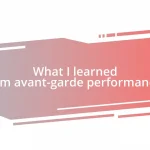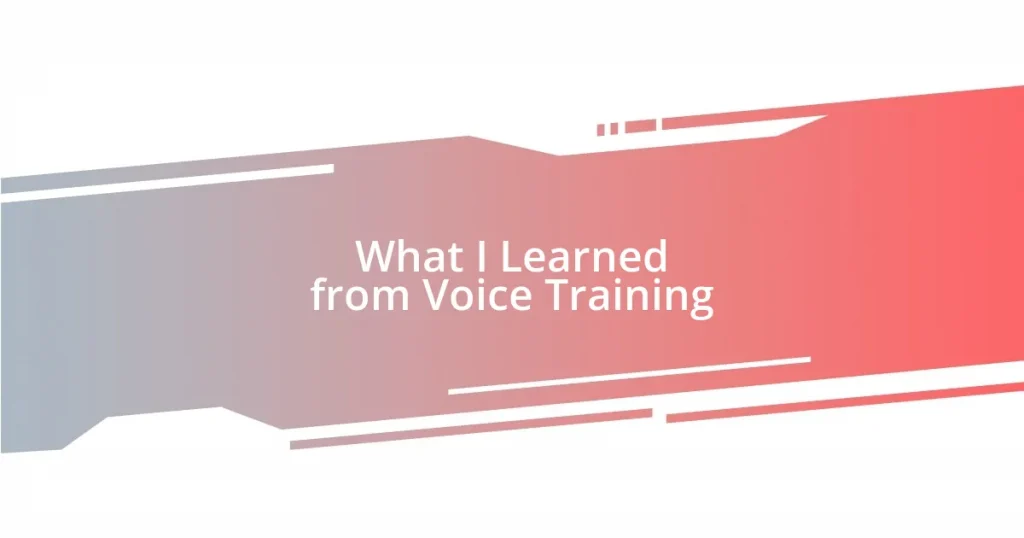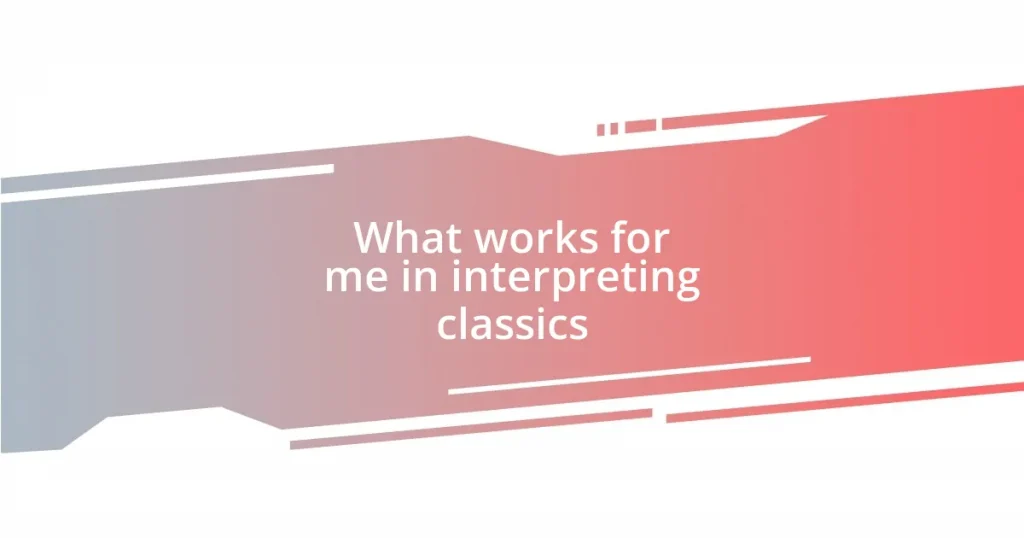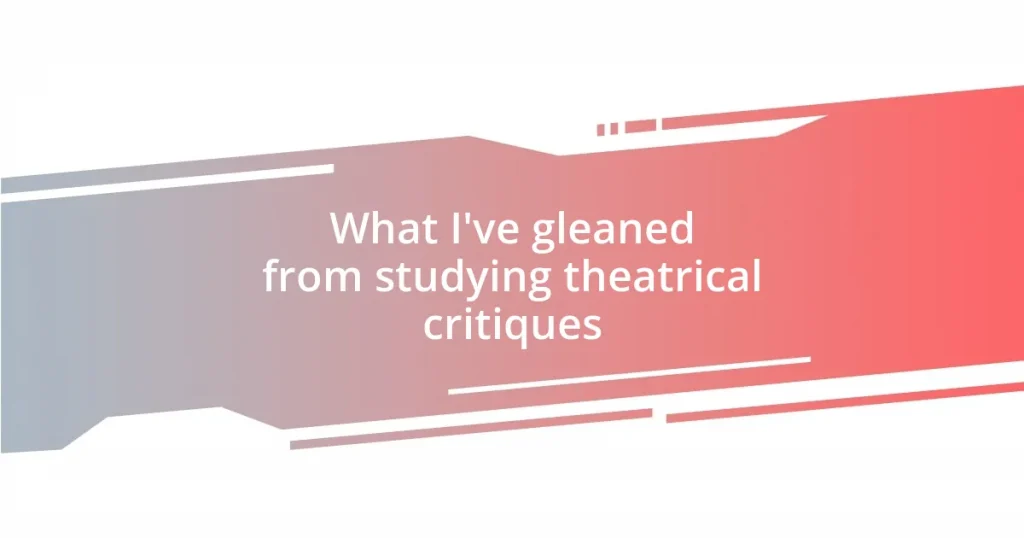Key takeaways:
- Voice training enhances self-expression and vocal clarity, allowing one to connect emotions with sound.
- Regular vocal warm-ups improve flexibility, breath control, and prevent injury, making practice more effective.
- Breath control techniques, including diaphragm breathing and strategic pauses, significantly bolster vocal performance.
- Overcoming stage fright involves mental visualization, breathing exercises, and practice in supportive environments to build confidence.
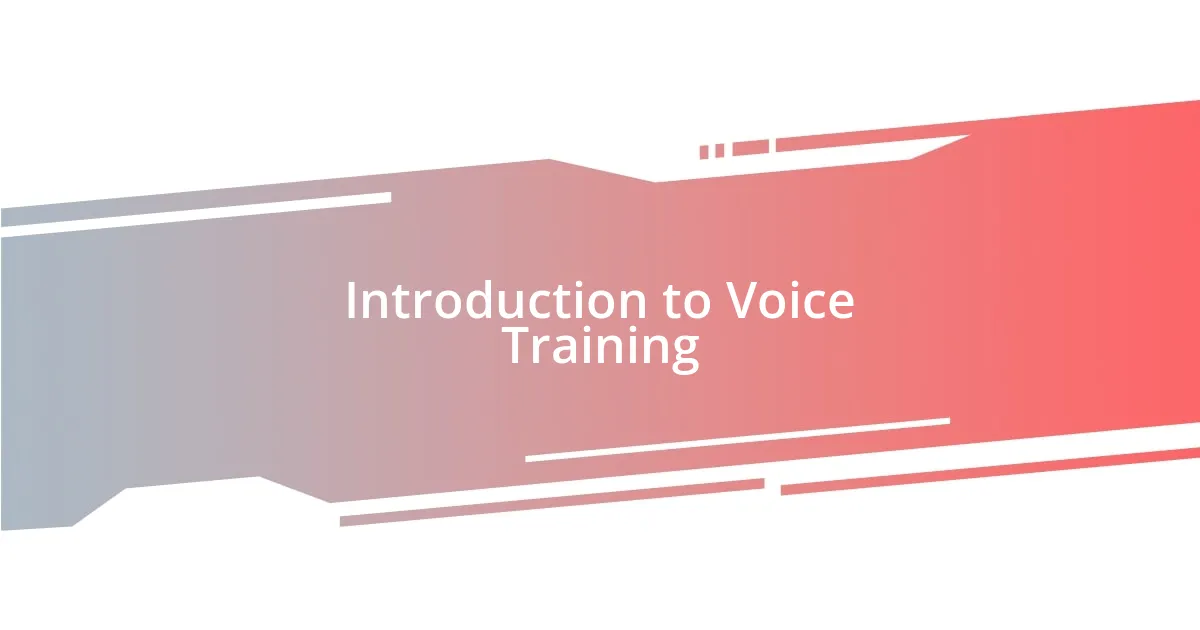
Introduction to Voice Training
Voice training has always fascinated me. When I first embarked on this journey, I didn’t just want to improve my singing; I sought to discover the true potential of my voice. It’s incredible how our vocal instruments can be shaped and refined to express not only notes but also emotions and ideas.
I remember my first lesson vividly. Standing in front of the mirror, I felt a mix of excitement and vulnerability as I tried to hit notes I never thought possible. Have you ever noticed how certain exercises can trigger unexpected feelings? That day, as I worked through breath control, I realized my voice wasn’t just a tool; it was a channel for my innermost self.
Voice training encompasses much more than just singing or speaking; it’s about growing as a communicator. Through techniques like breath support and resonance, I learned to wield my voice with intention and clarity. The beauty of it, I found, lies in understanding that we all have unique sounds to share with the world. How has your own voice journey started?
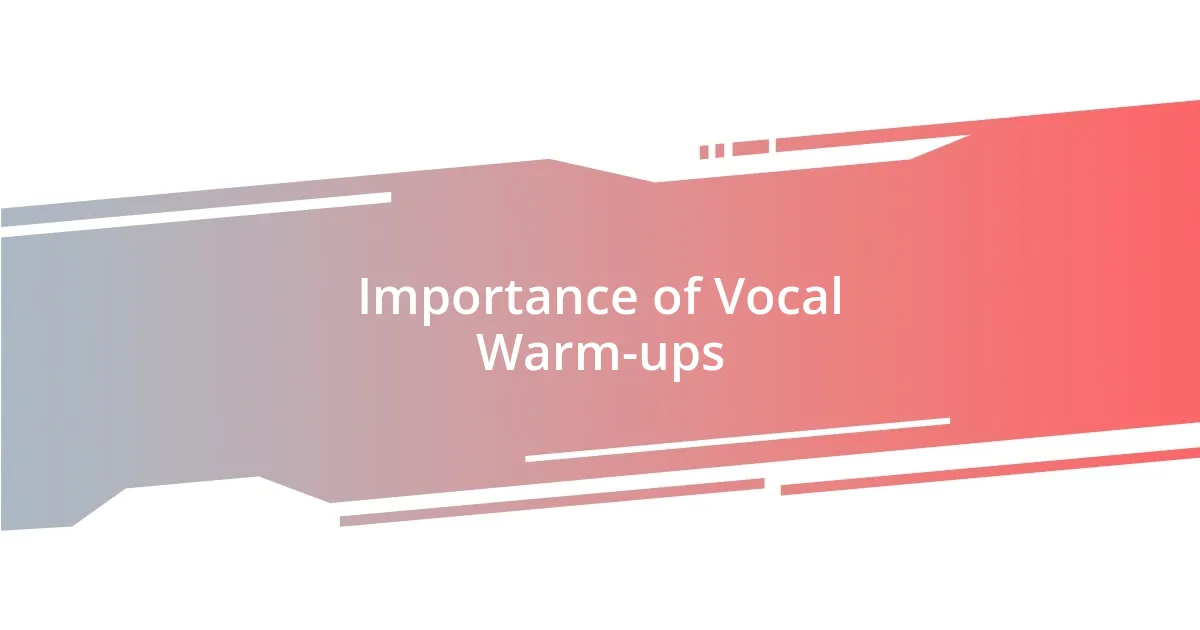
Importance of Vocal Warm-ups
Vocal warm-ups are essential for preparing your voice for the demands of singing or speaking. I can’t stress enough how often I skipped them at first, thinking I could dive right in. It wasn’t until I experienced vocal strain and fatigue that I understood their true value. A proper warm-up connects you with your instrument, helping you articulate better and sing with confidence.
Some key benefits of vocal warm-ups include:
- Improved Flexibility: Warming up helps increase vocal range by loosening your vocal cords, making it easier to hit those higher or lower notes without straining.
- Enhanced Breath Control: It’s astonishing how controlled breathing can change the quality of your sound. Warm-ups encourage deeper, steadier breaths.
- Prevention of Injury: By taking time to warm up, you significantly reduce the risk of vocal fatigue or strain, allowing for longevity in your vocal practice or performance.
- Heightened Awareness: These exercises help you tune into your body and voice, making you more aware of how to use them effectively.
In my experience, even a simple five-minute warm-up can make a world of difference. One morning, I rushed into practice without it and that lack of preparation echoed throughout my entire session. The sounds I produced felt tight and strained. Since then, I cherish those moments at the start of each practice, feeling my vocal cords awaken and my confidence build with each note.
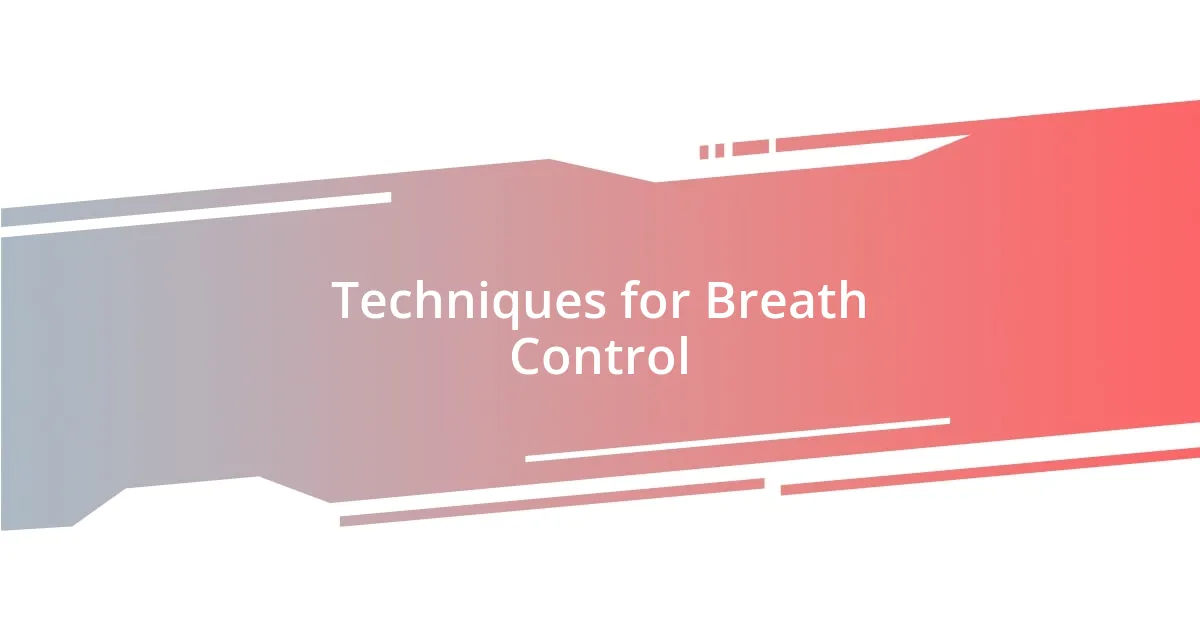
Techniques for Breath Control
Breath control is at the heart of effective vocal execution. I recall a time when I first learned about diaphragm breathing. Initially, I struggled to grasp the concept, which felt so foreign to me. It wasn’t until a mentor guided me through a simple exercise—placing a hand on my stomach and breathing deeply—that I felt the difference. When I focused on expanding my diaphragm instead of just my chest, my voice transformed. Suddenly, phrases flowed out with more power and clarity.
Another technique I found invaluable is the “hissing” exercise, where you take a deep breath and exhale slowly while making a hissing sound. This exercise not only helps me maintain steady airflow but also builds muscle strength around my vocal cords. Have you ever tried it? The first time I did, it felt challenging yet rewarding. I noticed an immediate improvement in my control over long phrases. It’s amazing how something so simple can lead to such profound changes in vocal performance.
Finally, the concept of “breath pauses” has become a vital part of my practice. Rather than rushing through a line, I learned to pause strategically to take in breath. This not only enhances my vocal delivery but allows the listener to absorb the emotions behind the words. The first time I applied this technique during a performance, I could feel the audience’s engagement shift, creating a stronger connection. These breathing techniques have indeed been game-changers for me.
| Technique | Description |
|---|---|
| Diaphragm Breathing | Focuses on breathing deeply into the diaphragm, improving voice support. |
| Hissing Exercise | Involves exhaling slowly with a hissing sound, enhancing control and breath strength. |
| Breath Pauses | Strategically placing pauses in your vocal delivery to enhance expression. |
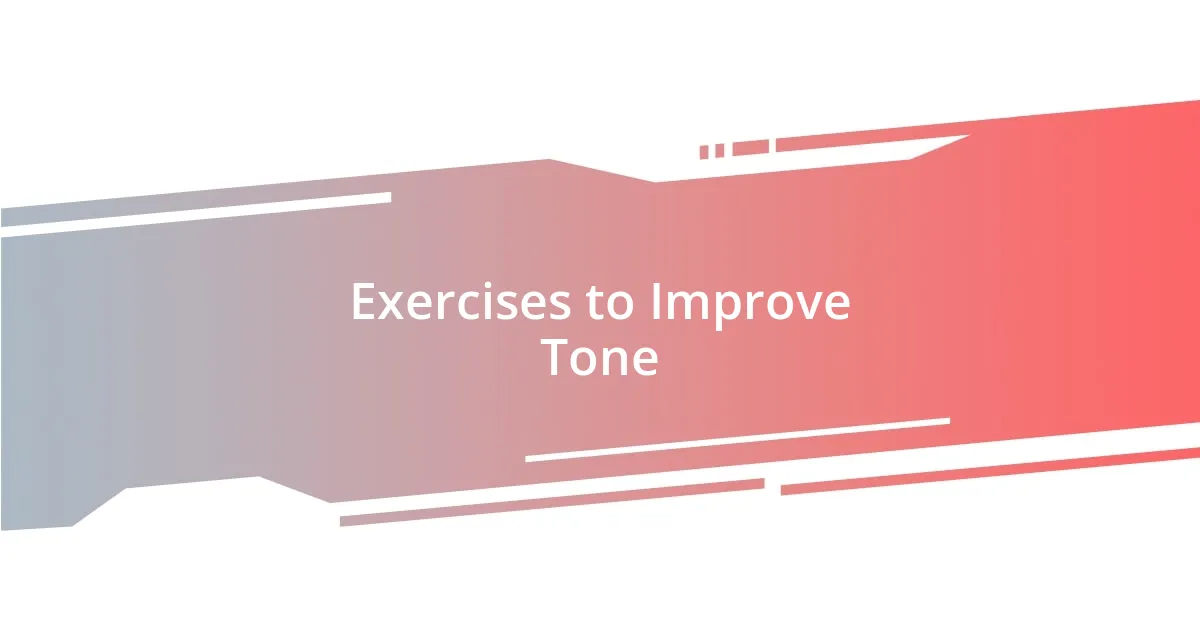
Exercises to Improve Tone
To truly improve tone, I’ve found that resonance exercises play a pivotal role. One that I particularly enjoy involves humming at different pitches, feeling the vibrations in my chest and head. Have you ever noticed how your voice feels different when you switch pitches? It’s like discovering a hidden layer to your sound. I remember when I first began experimenting with this exercise; I felt a newfound richness in my voice that completely changed how I approached singing.
Another effective exercise centers around vowel sounds. I often practice singing through the five main vowels (A, E, I, O, U) on a single pitch, focusing on clarity and projection. Initially, I was surprised at how much attention my tone received with just this simple practice. Just a few weeks in, I could hear the difference—the vowels began to resonate brightly, and my tone felt more inviting. When was the last time you dedicated focused time to just vowel sounds? It’s astonishing how something so seemingly basic can have such powerful effects on your overall vocal quality.
Lastly, incorporating scales into my routine has been game-changing for refining tone. I like to run through scales slowly, really focusing on evenness across each note. This exercise has helped me develop a fluidity in my voice I didn’t think was possible. I vividly remember struggling with certain notes in the past, but now, as I glide through the scales, I feel a sense of accomplishment and growth. With consistency, I not only improved my tone but also gained the confidence to explore new musical styles. Isn’t it satisfying to feel that kind of progress?
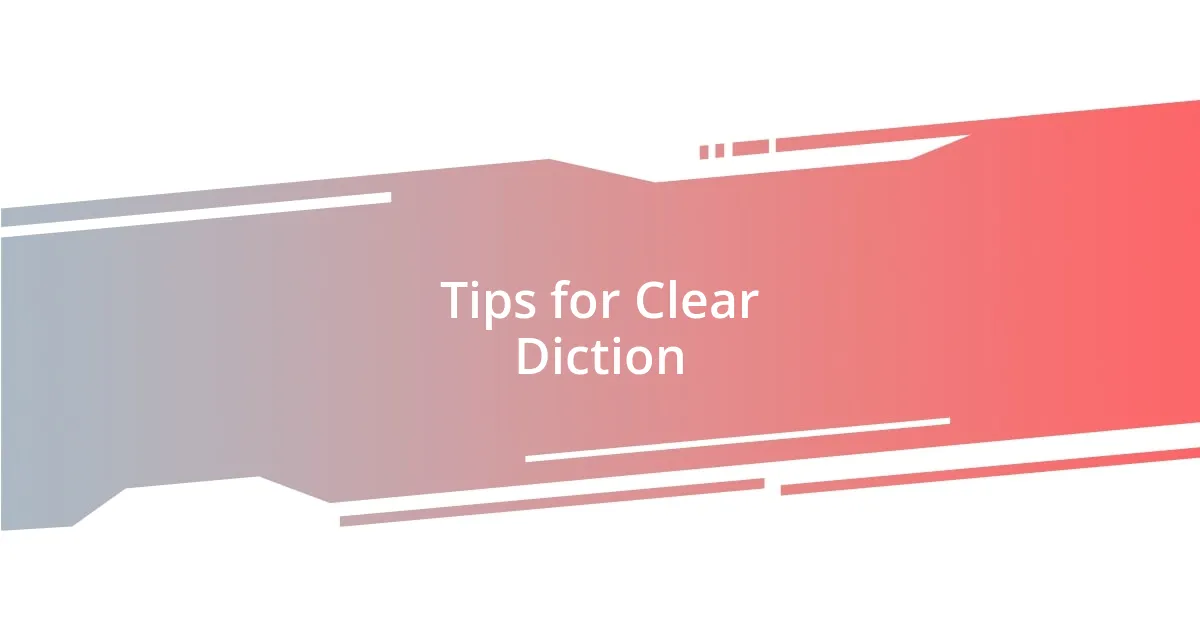
Tips for Clear Diction
One of the most underrated aspects of clear diction is articulating individual syllables. I remember a moment during a rehearsal when I stumbled over a line that should have been straightforward. My director suggested breaking down the words into their phonetic components. By slowing down and enunciating each syllable, what once felt like an uphill battle turned into a smooth delivery. Have you ever tried breaking words apart to find clarity? It’s amazing how this technique can transform seemingly complicated phrases into easily understandable speech.
Practicing tongue twisters has also been a revelation for me. At first, they seemed like a silly exercise, but once I committed to regular practice, I noticed a significant improvement in my enunciation. I still chuckle when I think about my first attempt at “Peter Piper.” I was tripping over my own tongue! Now, those tricky little phrases feel like second nature, and my confidence in speaking has soared. It’s a fun way to challenge yourself. Could something like this spice up your routine?
Lastly, incorporating mirror exercises into my diction practice has created a sense of awareness I never anticipated. Standing in front of a mirror, I focus on my mouth movements as I speak or read aloud. I recall the first time I did this exercise; it felt a bit silly, but watching myself added a new layer of connection with the words I was saying. It’s one of those eye-opening moments that reminds me just how much expression and clarity stem from proper mouth positioning. Have you considered using a mirror to refine your diction? It’s a simple tool that can yield remarkable results, giving you immediate visual feedback that truly enhances your speaking skills.
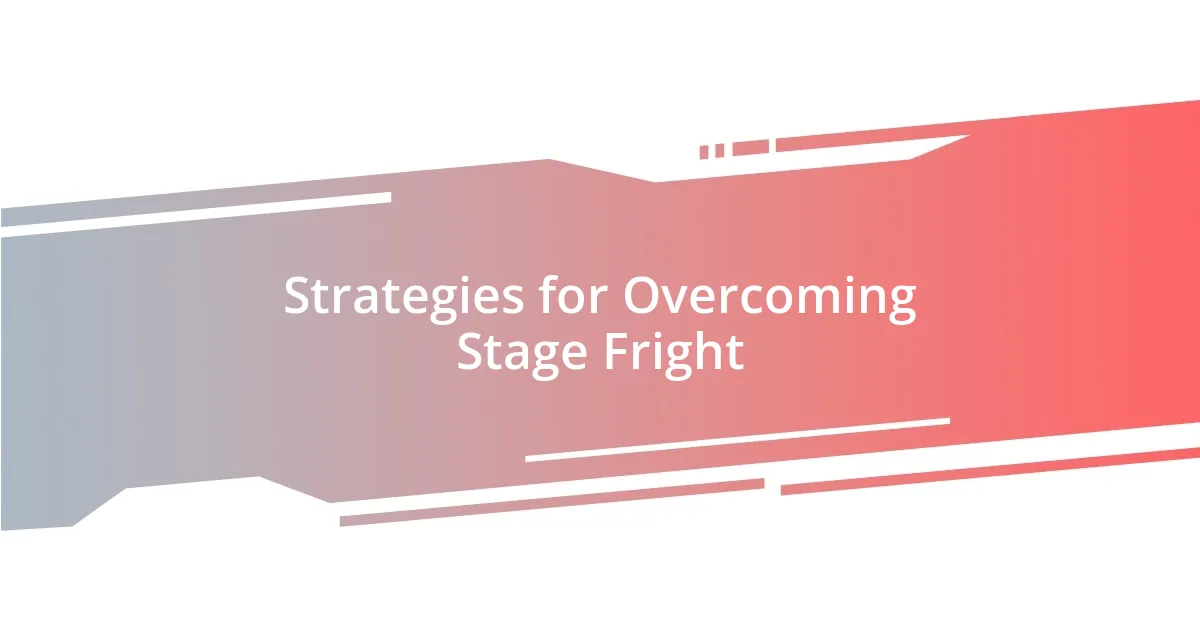
Strategies for Overcoming Stage Fright
Overcoming stage fright can be a journey, but I’ve found that visualization techniques make a substantial difference. Before stepping on stage, I like to close my eyes and imagine the performance going perfectly. Picture this: the audience laughs and applauds, and I feel a surge of confidence. This mental rehearsal has helped me feel more familiar with the experience, almost as if I’ve performed it countless times. Have you ever thought about how visualizing success could change your mindset?
Another strategy that has worked wonders for me is the power of breathing exercises. When I’m gripped with anxiety, taking a few deep breaths in through the nose and out through the mouth calms my racing heart. I remember one particularly nerve-wracking moment before a recital, where just a couple of rounds of deep breathing transformed my panic into focus. How often do we forget to breathe properly when we’re nervous? It’s incredible how such a simple act can ground you and preserve your clarity in the moment.
Lastly, practicing in front of trusted friends has proven to be invaluable. I recall my initial run-through, where my best friend sat with an encouraging grin—her presence made a world of difference. It felt less like a performance and more like an intimate conversation. There’s a certain comfort in sharing your art with those who support you. Have you considered inviting someone close to hear you perform before the real event? It can take the pressure off and build your confidence step by step.

Conclusion and Personal Insights
Voice training has profoundly impacted how I connect with my audience. I never expected that something as simple as adjusting my breath control could open up new pathways in my expression. There are moments when I feel a rush of vulnerability on stage, yet that control allows me to embrace it instead of shy away. Isn’t it interesting how the way we manage our breath can shift the entire dynamic of our performance?
Reflecting on this journey, I’ve come to appreciate the beauty of practice and the mistakes that come with it. I vividly remember a live event where I fumbled a line; initially, I felt embarrassed, but looking back, I can see it as a crucial moment of growth. Instead of trying to mask my imperfections, I learned to embrace them. Have you ever seen a performer stumble and then recuperate? Those moments of authenticity often resonate the most with an audience.
Ultimately, voice training has not just been about technique; it’s about finding my authentic voice and sharing it. I feel more empowered and equipped to tackle challenges, whether they’re in performance or daily conversations. Isn’t it heartening to realize that the journey toward clarity and confidence extends far beyond the stage? This journey, filled with self-discovery and expression, is one I cherish deeply.




